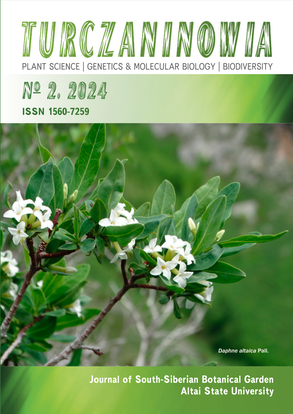Enchylium substellatum, a new lichen species for Russia
UDC 582.29:581.95(571.53)
Abstract
A description and location of a new lichen species for Russia, Enchylium substellatum, are given. The lichen was collected on fine earth at outcrops of crystalline limestone in the stony steppe on the Olkhon Island (Lake Baikal, west coast), in an area characterized by a wide distribution of island intrazonal mountain steppes. The issues of ecology and distribution of this rare lichen are discussed. It was discovered in the same ecotope with other calciphilous lichens (Heppia solorinoides, Gyalidea asteriscus, Toninia tristis, T. diffracta, Gyalolechia fulgens, Buellia elegans, Phaeorrhiza sareptana var. sphaerocarpa, Bilimbia lobulata, Physconia jacutica, Peltigera rufescens, Mycobilimbia obscurata, Lecanora epibryon, Rinodina roscida), some of which belong to the arctic-alpine element of the flora, some to the desert-steppe element, and most species are mountain xerophytes. Based on an analysis of the World distribution and habitats, it was concluded that Enchylium substellatum is an arctic-high-mountain calciphilous terricolous lichen associated with dry habitats. The distribution of the species is limited to the Holarctic, the range is extremely disjunctive. The species is found in cold mountain steppes, cold mountain deserts and dry arctic deserts.
Downloads
Metrics
References
Degelius G. 1954. The lichen genus Collema in Europe. Morphology, taxonomy, ecology. Symb. Bot. Upsal. 13(2): 1–500.
Degelius G. 1974. The lichen genus Collema with special references to the extra-european species. Symb. Bot. Upsal. 20(2): 1–215.
Gray S. F. 1821. A Natural Arrangement of British Plants according to each other, as pointed out by Jussieu, De Candolle, Brown etc. with an Introduction to Botany. London. 824 pp.
Hansen E. S. 1993. Collema substellatum and Fulgensia desertorum, new to Greenland. Lichenologist 25: 451–454. DOI: 10.1006/lich.1993.1009
Hansen E. S. 2008a. A contribution to the lichen flora of Johannes V. Jensen Land, northern Peary Land, North Greenland. Cryptog. Mycol. 29(1): 25–33.
Hansen E. S. 2008b. The lichen flora of Kuhn Ø and Blåbærdalen, easternmost Th. Thomsen Land, North East Greenland. Cryptog. Mycol. 29(4): 397–411.
Jørgensen P. M., Goward T. 2015. Notes on the Collema tenax complex, with recognition of two further species in the genus Enchylium (Ach.) Gray. Evansia 32(1): 42‒47. DOI: 10.1639/079.032.0101
Liu H. J., Wei J. C. 2009. A brief overview of and key to species of Collema from China. Mycotaxon 108: 9‒29.
Magnusson A. H. 1940. Lichens of Central Asia. I. In: Reports from the scientific expedition to the North-Western provinces of China under leadership of Dr. Sven Hedin. Publication 13, 22 XI. Botany. 1‒2. Stockholm. 168 pp.
Макрый Т. В. Глава 4. Лишайники // Споровые растения Прибайкальского национального парка. Новосибирск: Акад. изд-во “Гео”, 2008. С. 113‒259.
Otálora M. A. G., Jørgensen P. M., Wedin M. 2013. A revised generic classification of the jelly lichens, Collemataceae. Fungal Diversity 64(1): 275‒293. DOI: 10.1007/s13225-013-0266-1
Урбанавичюс Г. П. Список лихенофлоры России. СПб.: Наука, 2010. 194 с.
Turczaninowia is a golden publisher, as we allow self-archiving, but most importantly we are fully transparent about your rights.
Authors may present and discuss their findings ahead of publication: at biological or scientific conferences, on preprint servers, in public databases, and in blogs, wikis, tweets, and other informal communication channels.
Turczaninowia allows authors to deposit manuscripts (currently under review or those for intended submission to Turczaninowia) in non-commercial, pre-print servers such as ArXiv.
Authors who publish with this journal agree to the following terms:
- Authors retain copyright and grant the journal right of first publication with the work simultaneously licensed under a Creative Commons Attribution License that allows others to share the work with an acknowledgement of the work's authorship and initial publication in this journal.
- Authors are able to enter into separate, additional contractual arrangements for the non-exclusive distribution of the journal's published version of the work (e.g., post it to an institutional repository or publish it in a book), with an acknowledgement of its initial publication in this journal.
- Authors are permitted and encouraged to post their work online (e.g., in institutional repositories or on their website) prior to and during the submission process, as it can lead to productive exchanges, as well as earlier and greater citation of published work (See The Effect of Open Access).





